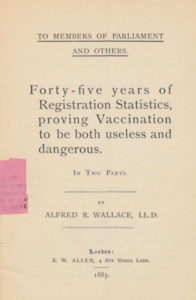Category Archives: Vaccine Injection Room
Minnesota: Somali community Measles epidemic 2017

Better measles than Autism…VLA
“During the last 10 years, there has been one death from measles, but that patient was an adult woman who was on immunosuppressive medications and had other serious health problems. (On the other hand, between) 2000 to 2017, there were 156 deaths related to the MMR vaccine.” — Dr. David Brownstein – Holistic Family Practitioner
The Somali community has seen an alarming incidence of ASD (currently 1 out of every 32 of their children are afflicted, the worst prevalence rate in any Minnesota demographic group, even exceeding the 1 out of 48 among the fully vaccinated white male children in Minnesota). Recall that concurrent with the alarming epidemic of ASD was a dramatic increase in live virus vaccines, mercury-containing vaccine and aluminum-containing vaccines. The incidence of ASD before 1986 (when the vaccine industry was exempted from liability for vaccine deaths or injuries) was 1 in every 10,000 Minnesotan children and the rate went to 1 out of 68 by the time the number of antigens injected routinely into Minnesotan children went from a dozen or so to upwards of 80!
Somalian children never came down with autism in their native land. It was only after they became war refugees and emigrated to Minnesota and started accepting CDC- and Minnesota Department of Health-mandated MMR vaccinations that the epidemic affected the community.
By refusing the MMR, they were accepting the risk of acquiring benign measles infections but they were decreasing the risk of allowing their children to acquiring the dreaded (likely vaccine-induced) autism that would ruin their lives forever. Their decision makes imminent sense and they should be applauded instead of vilified. Read more….
Sweden Outlaws Mandatory Vaccination
Sweden outlaws coercive mandatory vaccines laws, citing violations of the Swedish Constitution
(Natural News) It would seem that Sweden’s Parliament truly cares about doing what is best for its people. Rather than bowing to pressure by pharmaceutical companies or the scare-tactics of the mainstream media, the Swedish government recently adopted a decision to refuse to enforce the compulsory or mandatory vaccination of its citizens. Such a mandate, they noted, would violate the country’s Constitution.
Read more
2 minute: Del Bigtree vs. Bill Nye What is in the vaccines?
Preterm birth, vaccination and neurodevelopmental disorders
Preterm birth, vaccination and neurodevelopmental disorders: a cross-sectional study of 6- to 12-year-old vaccinated and unvaccinated children
Abstract
From about 8% to 27% of extremely preterm infants develop symptoms of autism spectrum disorder, but the causes are not well understood. Preterm infants receive the same doses of the recommended vaccines and on the same schedule as term infants. The possible role of vaccination in neurodevelopmental disorders (NDD) among premature infants is unknown, in part because pre-licensure clinical trials of pediatric vaccines have excluded ex-preterm infants. This paper explores the association between preterm birth, vaccination and NDD. READ STUDY…
Vaccinated vs. Unvaccinated study 6- to 12- year old U.S. children

Published in The Journal of Translational Science which were funded in part by Children’s Medical Safety Research Institute.
The children as a group were similarly mostly white (88%), with a slight preponderance of females (52%), and averaged 9 years of age. With regard to vaccination status, 261 (39%) were unvaccinated, 208 (31%) were partially vaccinated, and 197 (30%) had received all of the recommended vaccinations. All statistical analyses are based on these numbers.
Acute illness
Vaccinated children (N=405), combining the partially and fully vaccinated, were significantly less likely than the unvaccinated to have had chickenpox (7.9% vs. 25.3%, p <0.001; Odds Ratio = 0.26, 95% Confidence Interval: 0.2, 0.4) and whooping cough (pertussis) (2.5% vs. 8.4%, p <0.001; OR 0.3, 95% CI: 0.1, 0.6), and less likely, but not significantly so, to have had rubella (0.3% vs. 1.9%, p = 0.04; OR 0.1, 95% CI: 0.01, 1.1). However, the vaccinated were significantly more likely than the unvaccinated to have been diagnosed with otitis media (19.8% vs. 5.8%, p <0.001; OR 3.8, 95% CI: 2.1, 6.6) and pneumonia (6.4% vs. 1.2%, p = 0.001; OR 5.9, 95% CI: 1.8, 19.7). No significant differences were seen with regard to hepatitis A or B, high fever in the past 6 months, measles, mumps, meningitis (viral or bacterial), influenza, or rotavirus (Table 2).
Chronic Illnesses:
Vaccinated children were significantly more likely than the unvaccinated to have been diagnosed with the following: allergic rhinitis (10.4% vs. 0.4%, p <0.001; OR 30.1, 95% CI: 4.1, 219.3), other allergies (22.2% vs. 6.9%, p <0.001; OR 3.9, 95% CI: 2.3, 6.6), eczema/atopic dermatitis (9.5% vs. 3.6%, p = 0.035; OR 2.9, 95% CI: 1.4, 6.1), a learning disability (5.7% vs. 1.2%, p = 0.003; OR 5.2, 95% CI: 1.6, 17.4), ADHD (4.7% vs. 1.0%, p = 0.013; OR 4.2, 95% CI: 1.2, 14.5), ASD (4.7% vs. 1.0%, p = 0.013; OR 4.2, 95% CI: 1.2, 14.5), any neurodevelopmental disorder (i.e., learning disability, ADHD or ASD) (10.5% vs. 3.1%, p <0.001; OR 3.7, 95% CI: 1.7, 7.9) and any chronic illness (44.0% vs. 25.0%, p <0.001; OR 2.4, 95% CI: 1.7, 3.3). No significant differences were observed with regard to cancer, chronic fatigue, conduct disorder, Crohn’s disease, depression, Types 1 or 2 diabetes, encephalopathy, epilepsy, hearing loss, high blood pressure, inflammatory bowel disease, juvenile rheumatoid arthritis, obesity, seizures, Tourette’s syndrome, or services received under the Individuals with Disabilities Education Act (Table 3).
(n=261)
Chi-square
P-value
UN-Informed Consent 21st Century Cure Act-experimentation on the public
Watch video.. It is now rule of law. The legislation was passed. However, establishment attorneys are looking into including vaccine trials without informed consent. If the “commission” decides that the vaccine trials are “minimum” risk, the physician does not have to tell you that he is part of a clandestine public trial. Hence you and your children are being experimented on without being told. This is because the “commission” has determined that the particular medication has minimal risk…so NO INFORMED CONSENT IS REQUIRED.
VLA Comment: I wonder how they decide that there is minimal risk to a drug when the purpose of the trial is to find out??????
EMPLOYMENT: NO SHOTS, NO JOB, HIGHER PREMIUMS, PENALTIES

North Carolina Congresswoman Virginia Foxx, a Republican, has introduced new legislation that, taken to its logical end, might eventually provision for employers to force their employees to be vaccinated under the guise of “wellness.” House Resolution 1313, known as the “Preserving Employee Wellness Programs Act,” contains certain provisions for “disease prevention” that, should employees refuse them, might end up costing them their jobs. That, or employees could face penalties in the form of ostracization or even higher insurance rates. READ MORE….
VLA COMMENT: California already passed a law in tandem with SB 77 which prohibits public and private education for any child that is not fully vaccinated. This law targeting Daycare Centers prohibits employment or volunteering to anyone who has not gotten vaccinated. This is virtually the first time that the government mandate vaccines for employment.
VAXXED: Vitamin K Shot Caused Her Son’s Autism
Sesame Street (ELMO) SURGEON GENERAL FIRED BY TRUMP
TRUMP YANKS DR. MURTHY, SURGEON GENERAL
READ MORE…
The Federal Trade Commission’s STATUTORY AUTHORITY
The Commission’s basic authority to regulate advertising and marketing practices derives from Section 5 of the FTC Act, which broadly prohibits unfair or deceptive acts or practices in commerce. The Commission “will find deception if there is a representation, omission or practice that is likely to mislead the consumer acting reasonably in the circumstances, to the consumer’s detriment.” The elements to this analysis are:
(1) the representation, omission, or practice must be likely to mislead the consumer
(2) the act or practice must be considered from the perspective of the reasonable consumer
(3) the representation, omission, or practice must be material, that is, likely to affect a consumer’s choice or conduct, thereby leading to injury
(4) When a representation or sales practice is targeted to a specific audience, such as children, the Commission will determine the effect on a reasonable member of that group.
(5) Thus, advertisements directed to children are considered from the standpoint of an ordinary child.
The U.S. Food and Drug Administration
“…in connection with consumer-directed broadcast advertisements for prescription drug and biological products. The approach presumes that such advertisements:
Are not false or misleading in any respect
Present a fair balance between information about effectiveness and information about risk
Include a thorough major statement conveying all of the product’s most important risk information in consumer-friendly language
Communicate all information relevant to the product’s indication (including limitations to use) in consumer-friendly language.
Children’s Advertising Review Unit (CARU)
CARU’s Self-Regulatory Guidelines are deliberately subjective, going beyond the issues of truthfulness and accuracy to take into account the uniquely impressionable and vulnerable child audience.
The Guidelines are based upon the following core principles:
Advertisers have special responsibilities when advertising to children or collecting data from children online. They should take into account the limited knowledge, experience, sophistication and maturity of the audience to which the message is directed. They should recognize that younger children have a limited capacity to evaluate the credibility of information, may not understand the persuasive intent of advertising, and may not even understand that they are being subject to advertising.
Advertising should be neither deceptive nor unfair, as these terms are applied under the Federal Trade Commission Act, to the children to whom it is directed.
Advertisers should have adequate substantiation for objective advertising claims, as those claims are reasonably interpreted by the children to whom they are directed.
Advertising should not stimulate children’s unreasonable expectations about product quality or performance.
Products and content inappropriate for children should not be advertised directly to them. Advertisers should avoid social stereotyping.

